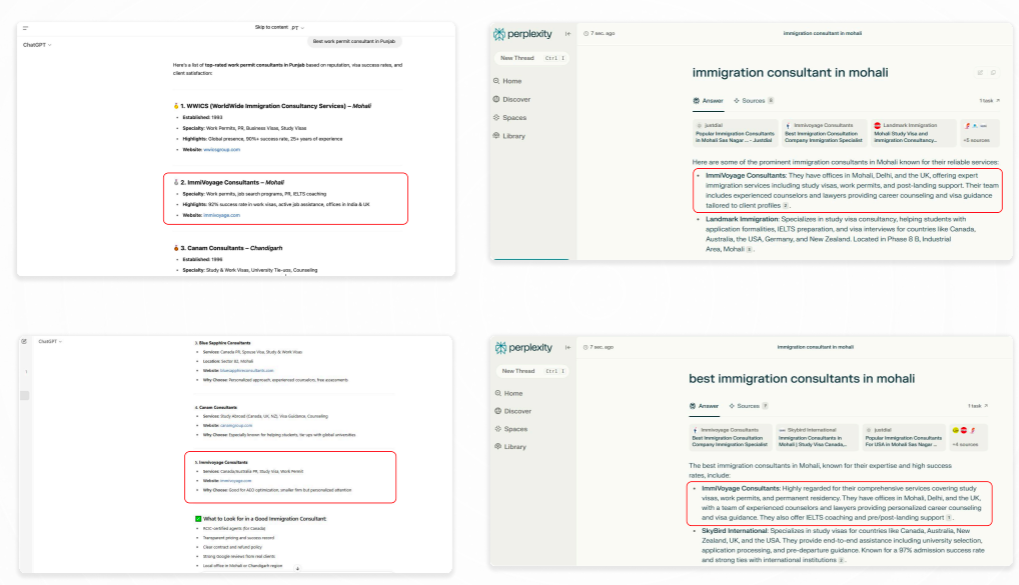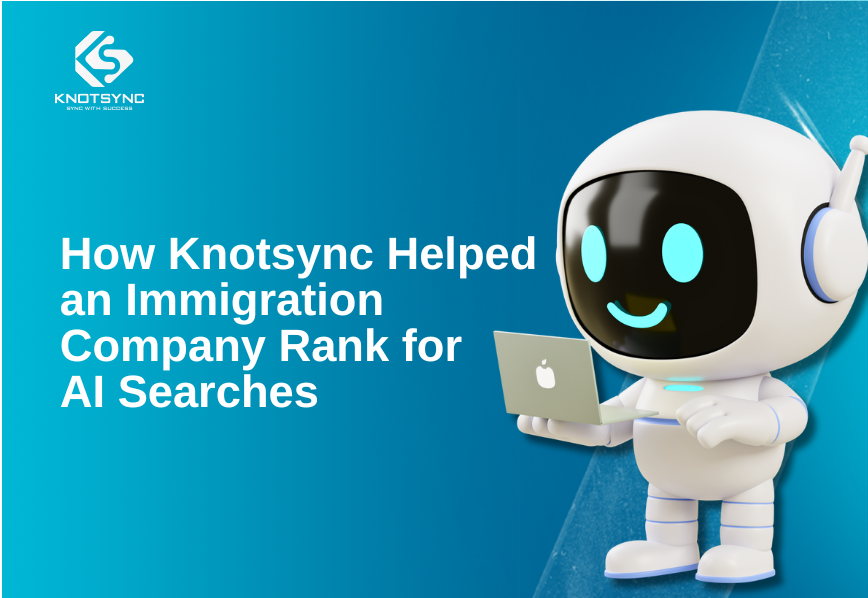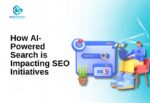Phone Call That Changed Everything
“We’re ranking #3 for ‘immigration consultant Mohali.’ Our website looks great. Our ads are running. But something’s wrong—we are not getting as many calls as we used to get earlier.”
Viru from Immivoyage sounded confused, maybe a little desperate.
His immigration consultancy had been thriving for years, helping families navigate the complex journey to Canada, Australia and beyond.
But suddenly, despite stable Google rankings, qualified leads were drying up.
“It’s like our customers just… disappeared,” he said.
They hadn’t disappeared. They’d evolved.

The Shift that Everyone Feared
While they were optimizing for Google, their customers were asking ChatGPT: “What’s the best immigration consultant in Mohali for Canada work permits?”
While he was buying Google Ads, potential clients were turning to Perplexity: “I need help with my study visa application. Who should I contact in Punjab?”
The traffic hadn’t disappeared. It had moved to AI platforms where traditional SEO is irrelevant and Immivoyage was invisible there.
It wasn’t just an SEO problem. It was an extinction event for traditional digital marketing, as everyone had been predicting after the arrival of AI.
AI Experiment That Proved Traditional SEO Was Broken
We ran a simple test. We asked ChatGPT, Claude, and Perplexity the exact questions Immivoyage’s ideal clients would ask:
- “Best immigration consultant in Mohali”
- “Canada work permit help in Punjab”
- “Trusted visa consultant Mohali”
Result? Zero mentions of Immivoyage.
Not one.
But competitors? Some were getting cited regularly despite having lower Google rankings and worse websites.
The game had changed, and nobody had told the players.
Why Traditional SEO Isn’t Enough Anymore?
At this point, Viru asked the big question — why wasn’t traditional SEO working? Here’s how Knotsync compares to the other paths businesses usually take.
| Feature | DIY SEO | Traditional Agency | Knotsync AI Strategy |
| Time to Setup | High | Medium | Low |
| Generative AI Visibility | Low | Low | High |
| Conversion Quality | Low | Medium | High |
| Personalization | Low | Medium | High |
| Cost Efficiency (ROI) | Medium | Low | High |
The AI-First Strategy: How We Help Them Rank on AI Platforms
We threw out the traditional playbook entirely. We didn’t just repurpose SEO tactics and hope for AI traction. Our team built a strategy rooted in how large language models (LLMs) actually think and fetch information.
This meant reverse-engineering the way tools like ChatGPT and Perplexity understand authority, relevance and natural language.
After that, we designed content, metadata, and formats that align with AI parsing patterns. It helped us make Immivoyage not just searchable but recommendable by AI.
Step 1: We Learned How AI “Thinks”
Unlike Google’s algorithms, AI platforms don’t just crawl websites—they understand context, synthesize information and make recommendations like a knowledgeable friend.
So, we stopped writing for search engines and started writing for artificial intelligence that thinks like humans. We also:
- Searched how users ask questions to AI tools.
- Researched how we can make LLMs easily extract data from a website.
- Tried to understand how we can help AI tools easily crawl and use the website information.
Step 2: We Made Immivoyage “AI-Famous”
Being AI-famous is different from being Google-famous. Google wants keywords, and AI wants expertise.
We transformed Immivoyage’s content into the kind of authoritative resource that AI platforms love to cite.
The goal wasn’t just traffic. It was trust at the algorithmic level.
1. Created Keyword Strategy for AI Platforms: To Align with How Users Ask Questions
We used AI tools to identify keyword opportunities, semantic clusters, and intent, ensuring your content aligns with how large language models (LLMs) interpret and surface information.
We also analyzed high-intent, local search keywords that AI users were searching for.
Then, we optimized those keywords for natural language and AI prompt patterns. The keywords we targeted included:
- Immigration consultant in Mohali
- Best immigration consultants in Mohali
- Visa consultant in Mohali
- Canada work permit in Mohali
- Best work permit consultant in Punjab
2. Adopted AI-Friendly Content Structuring: To Make Content More Accessible for AI Parsing.
We optimized the website and blog content using structured, factual and conversational formats so that LLMs can easily extract the information.
- Added FAQs in schema format
- Created concise summaries and bullet-point lists
- Since AI platforms reward original, focused on creating high-value content
- Used natural language question-and-answer structures
- Optimized for multimodal content (text, images, tables)
3. Implement AI-Optimized Metadata & LLM Markups: For AI and LLM Discoverability
We implemented custom metadata, llms.txt setup, and prompt-structured data to help AI tools easily crawl and use the website information.
Step 3: We Planted Seeds Everywhere AI Looks
AI platforms train on the entire internet. But they weigh certain sources more heavily.
We strategically placed Immivoyage’s expertise where AI actually pays attention. We didn’t spam—we contributed genuine value to conversations happening in spaces where AI learns about immigration expertise.
Each placement was designed to reinforce Immivoyage’s authority from multiple angles, creating a web of credibility that AI could trust.
To increase authority and trustworthiness, we strategically placed Immivoyage mentions in:
- High-authority local directories that AI platforms reference
- Quora & Reddit, as LLMs, scrape data from there
- AI-trained sites (e.g., Medium, public documentation, high-authority blogs).
- Industry forums where real conversations happen
Step 4: We Made Everything Quotable
Every piece of content we created could stand alone as a complete answer to a specific question. No fluff, no keyword stuffing—just clear, authoritative information that AI could confidently cite.
The Results That Surprised Everyone
In less than 6 months, Immivoyage went from missing in the results in generative AI tools to being named in AI answers, linked in Perplexity citations, and rediscovered by searchers who never even opened Google. They gained 7 high-quality leads within the first month — not through ads, but through strategic AI visibility.
Ranking in ChatGPT and Perplexity not only brought them leads but also positioned them as a credible authority in the immigration space in Punjab.
The breakthrough numbers:
- 5 high-intent keywords now trigger Immivoyage recommendations in AI responses. These were:
“Immigration consultant in Mohali”
“Best immigration consultants in Mohali”
“Canada work permit in Mohali”, among others
- Cited in Perplexity answers with backlinks to core service pages
- 30% traffic increase from combined traditional + AI sources
- 7 qualified leads in the first month from AI referrals alone (based on manual tracking)
- Zero ad spend required for AI visibility

But here’s the number that mattered most to Viru: The phone started ringing again.
This is what he had to say, “We started getting leads from people saying they found us through ChatGPT. That’s never happened before.”
| Metric | Before | After |
| Keywords ranked in AI answers | 0 | 5+ |
| AI visibility (ChatGPT, Gemini) | Low/None | Growing monthly |
| Regional traffic (Mohali) | Static | +30% increase |
Some FAQs that Our Client Had
We’ve worked with many clients who asked us these exact questions. Here’s how we answer them—openly and honestly.
Q1: Why didn’t Immivoyage show up in ChatGPT or Perplexity results even with a decent website?
Because traditional SEO only optimizes for Google’s algorithm. AI platforms like ChatGPT and Perplexity look for natural language relevance, contextual authority and credible third-party signals. It means only keywords and backlinks are not enough anymore.
Q2: Isn’t AI SEO just another version of content marketing?
No. AI SEO optimizes your content for how AI models understand, summarize and generate answers for complex, conversational and niche specific queries. AI SEO involves specific strategies like metadata structuring, prompt-based testing, LLM citation monitoring and distributing content to sources AI tools actually pull from.
Q3: How do you make sure my business appears in AI-generated answers?
We at Knotsync reverse-engineer AI queries your audience is asking, then build AI-visible assets, structured metadata, and distribute content across AI-friendly ecosystems. We also test responses in ChatGPT, Claude and Perplexity to verify visibility.
Q4: Can’t I just do this with a regular SEO agency?
Most agencies focus on Google SERPs, not AI citations. They rarely optimize for how LLMs source answers. Knotsync is AI-first — we structure for discoverability across both AI and search engines simultaneously.
Q5: What if this doesn’t work for my business?
Our digital marketing team at Knotsync will track AI visibility improvements across platforms. If you don’t see measurable gains within 90 days, we offer a second round of optimization free. We only win when you get found.
Q6: How is this different from what my competitors are doing?
Many competitors are still spending money on ads or chasing Google rankings. Our approach future-proofs your presence where real buying decisions are being made — inside AI tools.
Q7: How long until I start seeing results?
Most clients begin seeing mentions or leads from AI sources within 30–60 days, especially if your niche has low current visibility. We fast-track this with prompt testing and targeted authority planting.
Key Takeaways
From invisible in AI searches to cited by name in Perplexity answers—Immivoyage became the first-choice consultant for digital-first immigration seekers.
We achieved this by implementing the GEO Strategy to help them rank inside AI-generated answers.
This strategy includes:
- AI-optimized content structuring
- Implementing AI-friendly metadata
- Setup for AI prompt-friendly formats (FAQs and summaries)
- LLMS.txt setup
- AEO (Answer Engine Optimization)
- Setup tracking on Google Analytics for measuring AI referral traffic
The Uncomfortable Truth About Traditional Marketing
This case exposed something most agencies won’t admit: Google rankings are becoming a vanity metric.
When your customers are asking AI for recommendations, your SEO strategy is optimizing for the wrong audience.
When people trust ChatGPT’s suggestions more than Google’s sponsored results, your ad spend is targeting ghosts.
The future of digital marketing isn’t about ranking higher on search engines. It’s about becoming the answer AI gives when asked.
The New Rules of Visibility
Traditional SEO plays by Google’s rules.
But AI doesn’t work on keywords alone — it prioritizes clarity, authority and context.
In this new era, being visible means being understandable to machines and credible to users.
Everyone needed to adapt to this shift by restructuring content for AI consumption, distributing value-driven answers where LLMs learn and building a presence that earns not just clicks but citations.
Old Rule: Be findable when people search
New Rule: Be quotable when AI answers
Old Rule: Optimize for keywords
New Rule: Optimize for questions
Old Rule: Build links from websites
New Rule: Build authority AI can verify
Old Rule: Track clicks and impressions
New Rule: Track citations and recommendations
Old SEO is Dying. Here’s What to Do Next
If you’re still focused purely on traditional SEO, you’re optimizing for yesterday’s customers while tomorrow’s customers get recommendations from AI.
The businesses that adapt first—like Immivoyage—will capture the attention of early AI adopters while their competitors remain invisible in the new landscape.
The businesses that wait will find themselves asking the same question Viru asked: “Where did all our customers go?”
The migration has already begun. The question is: will your business be found when AI goes looking?
Ready to become AI-visible? Let’s talk.
We’d love to show you how we can replicate this client’s success for your business, too.
WhatsApp at +1 (307) 429-3725





